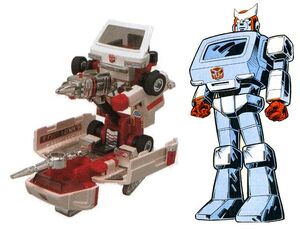
So when we were kids, some of us pretended that he combined with that sled thing to make the full robot. But that's just crazy talk.
Transformers characters are frequently represented in multiple different media, ranging from plastic toys to animation to comic books. Their appearances frequently vary between these, leading many fans to select one version that represents the character's "real" appearance and rate others in terms of their similarity to this one. Show-accuracy is typically a toy's resemblance to the animation's depiction of the same character; conversely, toy-accuracy is a show character's degree of similarity to the corresponding toy.
In most cases, Transformers are designed as toys first, with cartoon and comic character models being artists' interpretations of the toy designs. As such, for the most part it is toy-accuracy that has the most relevance to the production process. A notable exception to this rule is The Transformers: The Movie, which featured a large group of new characters whose toys were based on animation designs, rather than vice-versa.
Occasionally, toy and fiction designs are created cooperatively, such as the case of the live-action movie toys and Transformers Animated series. Hasbro worked closely with ILM and Cartoon Network to ensure that the fictional designs for each series were workable as toys and ensure they could get the toys and fiction as close visually as possible (accounting, of course, for the movie and toy line's differing production schedules).
Another exception frequently happens with Takara's releases of Transformers franchises in Japan. Due to the delays in importing shows, Takara frequently has the chance to tweak their releases to resemble the respective animation models better, mostly in regard to color schemes. The most notable example of this was the Japanese release of Beast Machines as Beast Wars Returns; the cartoon had already been around for years, so it was far easier for Takara simply to produce the toys in different, show-based colors.
In early Generation One in particular, toy-accuracy and show-accuracy are both frequently very low, with the character models differing greatly from the toys. Recently, however, the gap has narrowed, and modern fictional appearances of Transformers are often nearly identical to the toys, sometimes to the absurdly literal point of including design oddities that probably wouldn't exist on "real" Transformers. The character model for Evac, for example, includes the push button that spins the toy's rotor blades.
In a few cases, Generation One reissues have been retooled to enhance their resemblance to their animated counterparts. In the case of the Galvatron reissue, Takara not only retooled the toy but went so far as to redeco it.
Various non-transforming toys have been made that are designed to resemble Generation One cartoon character designs better. Several Action Masters bore closer resemblance to their animation models (though many had color differences, if not outright sculpt issues). More recently, there have been lines such as the highly cartoon accurate Mega SCF line and the Revoltech line. (Though their designs specifically resemble Dreamwave's art style rather than Generation One cartoons, Dreamwave's designs are frequently heavily based on Generation One-based models.)
Many non-posable (or at least, not very posable) figurines exist based on animation models as well, such as the Heroes of Cybertron (or 'SCF'; not to be confused with Mega SCF) line, Titanium Series Robot Masters (not to be confused with Robot Masters), or stylized examples like the Robot Heroes line.
Additionally, several newer Transformers take Generation One cartoon designs into account to varying degrees, such as the Masterpiece figures, Robot Masters figures, or more abstractly show-accuracy-inspired examples like the Titanium Cybertron Heroes G1 figures and the Classics and Universe lines. Occasionally, new designs for a given series resemble old G1 characters for whom there were no, few (such as Energon's heavily G1-esque Galvatron/Megatron), or less show-inaccurate toys; for example, the Armada Unicron toy is the closest (and presently only) transforming likeness to the 1986 animated Unicron.
